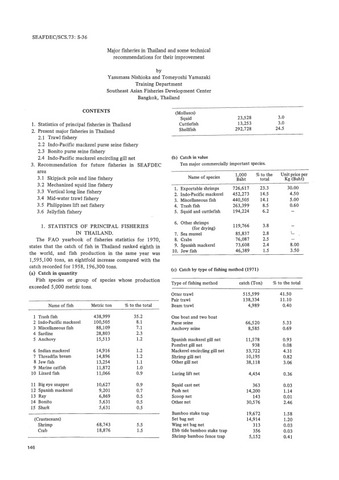Status of Fishing Conditions in Cambodia
Share
Abstract
Fisheries in plays a very important role in Cambodia’s national economic development. Total fish catch production in 1996 was 104 310 tones, about which 60% was contributed by inland capture fisheries, 30% by marine capture fisheries and 10% by both inland and marine aquaculture (Fish catch in Cambodia 1980-1996). Even inland capture fisheries have contributed high production we also always pay attention to our marine capture fisheries which have provided its enormous production to our country. Our coastal line extends 435 km from Thai border in the Northwest to Vietnamese border in the Southeast with Exclusive Economic Zone area of 69, 900 square miles. (Map of the marine fishing ground). The main living animal aquatic species: fish (mackerels, sardine, anchovies, bonito, flatfish, snapper, threadfin, etc., (main marine aquatic catch in 1996). 1. Fishing gears: There are two types of marine fishing gear in our country small scale family fishing gear and commercial fishing gear. For the commercial fishing gear, the most popular ones are purse seine and bottom trawl. (Marine fishing gears in 1996); 2. Fishing boats: In 1996 fishing boat increases until 4914 units, which 1602 units are motorized boats and 3312 units are non motorized ones. However, they are not modern, and they do not have any modern equipment such as radar, echo-sounder (fish finder), sonar sounder, power block, net hauler and refrigeration system, (marine fishing boat in 1996); 3. Marine fishers: Total marine fishers in four provinces in 1996 are 68745 persons (24 464 families) slightly increases from 1995. Most of them are poor; they get their small income from their fishing activity. (Marine fishers in 1995 and 1996); 4. Marine fishing policy: Department of Fisheries has its own fisheries law and policy to deal with all kinds of fisheries activities in our country sustainably. It contains many articles that all fishers have to respect, as following; 5. Fishing constraint: Even we have strict fisheries law, but we still face many problems because of illegal fishing are carrying out in the whole country and damaging our natural aquatic resources. The constraints are the following; 6. Fisheries planning: Facing difficulty and problems with the aims of fisheries development and management the Department of Fisheries has its five-year planning and projects, in the following. The Department of Fisheries has achieved its advancement during the last 16 years and faced many problems to be solved in the future. Due to 20 years of civil war, our government has a limited budget for spending on the fisheries sector including insufficient of its human resource. So we would like to take this opportunity to have some suggestions, if possible, to the workshop, to other organizations to provide us short and long course training on fisheries sector and resources development and management in a sustainable way, and one more is cooperation in oceanographic scientific research. The last assist us by providing technology document.
Suggested Citation
Sour, K., & Vuthy, R. (1997). Status of fishing conditions in Cambodia. In Proceeding of the Regional Workshop on Responsible Fishing, Bangkok, Thailand, 24-27 June 1997 (pp. 152-160). Samut Prakarn, Thailand: Training Department, Southeast Asian Fisheries Development Center.
Subject
fisheries  ; artisanal fisheries
; artisanal fisheries  ; inland fisheries
; inland fisheries  ; marine fisheries
; marine fisheries  ; economic benefits
; economic benefits  ; commercial species
; commercial species  ; aquaculture
; aquaculture  ; aquaculture development
; aquaculture development  ; fishery management
; fishery management  ; fishery resources
; fishery resources  ; resource management
; resource management  ; Exclusive economic zone; fishery regulations
; Exclusive economic zone; fishery regulations  ; Fishery policy; fish
; Fishery policy; fish  ; fisheries development
; fisheries development  ; fishing gear
; fishing gear  ; fishing
; fishing  ; fishing vessels
; fishing vessels  ; fishers
; fishers  ; Fishery industry; Cambodia
; Fishery industry; Cambodia
 ; artisanal fisheries
; artisanal fisheries  ; inland fisheries
; inland fisheries  ; marine fisheries
; marine fisheries  ; economic benefits
; economic benefits  ; commercial species
; commercial species  ; aquaculture
; aquaculture  ; aquaculture development
; aquaculture development  ; fishery management
; fishery management  ; fishery resources
; fishery resources  ; resource management
; resource management  ; Exclusive economic zone; fishery regulations
; Exclusive economic zone; fishery regulations  ; Fishery policy; fish
; Fishery policy; fish  ; fisheries development
; fisheries development  ; fishing gear
; fishing gear  ; fishing
; fishing  ; fishing vessels
; fishing vessels  ; fishers
; fishers  ; Fishery industry; Cambodia
; Fishery industry; Cambodia
Related items
Showing items related by title, author, creator and subject.
-
Major fisheries in Thailand and some technical recommendations for their improvement
Nishioka, Yasumasa; Yamazaki, Tomeyoshi (Japan International Cooperation Agency, 1977)Presented in this paper is the development of fisheries industry in Thailand. The data on the production of the principal fisheries species and major fishing methods are also presented. Also included are the recommendations ... -
The Status of Fisheries in the Republic of Maldives
Faiz, Mohamed (Training Department, Southeast Asian Fisheries Development Center, 1997)The paper discusses the tuna fisheries in Maldives which dominates its fishing industry. Apart from a very strong domestic market, tuna is also the main export commodity of the country. Moreover, reef fisheries such as, ... -
Fishing Status of Thailand
Chullasorn, Somsak; Chotiyaputta, Cherdchinda (Training Department, Southeast Asian Fisheries Development Center, 1997)Marine fishery of Thailand characterized as multi-species and multi-gear fishery. The continuous advances in fishing technology make marine production increasing annually that resulted in depletion of the stocks particularly ...




